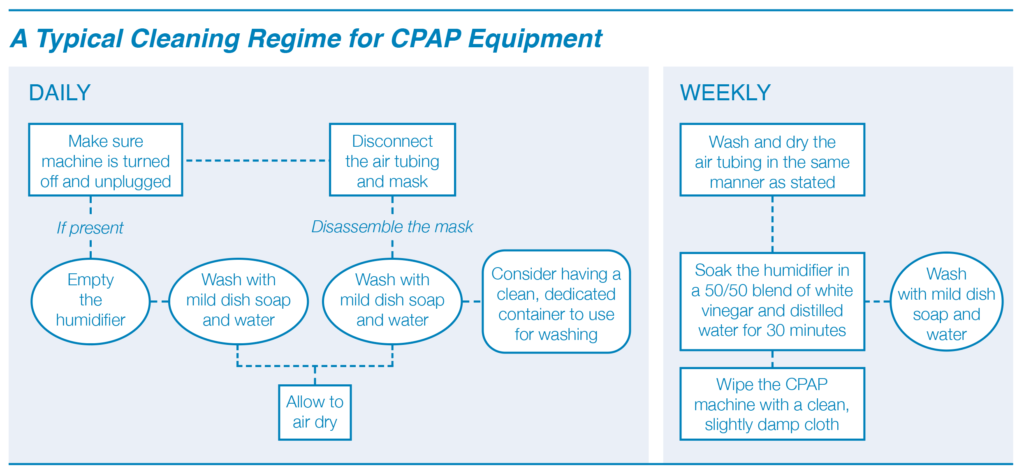Avoiding Ozone & UV CPAP Cleaners: Learn Safe, Easy and Natural Alternatives for Cleaning
CPAP machines are used daily, coming into constant contact with the oils from faces and moisture from respiration. That means they need to be cleaned regularly in order to work well. And for the millions of Americans who rely on CPAP machines, it goes without saying that they would want to make cleaning and maintenance as fast and easy as possible.
Ozone and UV Light Cleaning
That’s where the marketing for ozone and UV light cleaning devices comes in.
The idea is that these devices disinfect CPAP equipment with virtually no effort from the user. You can see the popularity with a quick Google search of “best way to clean a CPAP machine.” Reviews are all over YouTube and they’re even sold on the websites of major retailers like Walmart.
Unfortunately, the FDA Believes These Devices May Be Dangerous
On February 27, 2020, the FDA sent out official safety communications making it clear that these devices aren’t legally allowed to be marketed as CPAP cleaning machines.1 A small but concerning number of people have experienced maladies, including asthma attacks, after using ozone devices with their CPAP equipment.
To date, none of these devices have gone through the necessary testing and regulatory process to prove their efficacy for CPAP usage. In fact, the FDA has tested both ozone and UV light devices and found that they can pose risks to both CPAP equipment and users’ health.
What Are the Issues with Ozone Devices?
Also known as “activated air,” some of these devices pump ozone into CPAP masks and tubes, and some pump ozone through the CPAP machine itself. The problem is that ozone is a toxic gas, and for it to effectively kill bacteria, the concentration must be higher than is safe for humans to breathe.
According to the FDA’s findings:
- Leaks can occur where ozone is vented into rooms, posing a risk to all inhabitants.
- The ozone inside CPAP machines and equipment may not be fully dissipated even when following the manufacturer wait time of several hours.
- Breathing ozone through a CPAP machine can cause a range of breathing problems and increase susceptibility to respiratory infection.
According to other sources, exposure to ozone can also cause pulmonary edema (excess fluid in the lungs), which typically takes several hours for symptoms to occur.2 Being that many CPAP users would be sleeping at that interval, ozone devices seem like an unnecessarily risky way to clean.
What Are the Issues with UV Devices?
Although there have not been reports of injuries associated with UV devices, the nature of UV light and the construction of CPAP machines presents both dangers to the user and a lack of reliability for disinfection.
According to the FDA’s findings:
- UV devices without adequate shielding can cause eye damage and even skin cancer.3
- UV devices offer varying degrees of power, some may not be strong enough for disinfection.
- Many hoses, tubes and other components do not allow full, consistent UV light penetration.
- That means they simply cannot be reliably disinfected with any UV light device.
If You Shouldn’t Use Ozone or UV Cleaners, What Should People Use?
While automated solutions would be nice, there simply aren’t any types or models that health authorities recommend at the time of writing. But the good news is that CPAP cleaning and maintenance can be very quick and easy with inexpensive, organic products. As always, users should follow the CPAP manufacturer’s recommendations, but here are some general tips.
Mild Dish Soap
Mild dish soap is most commonly recommended for daily cleaning of CPAP accessories, and there are a number of fully biodegradable, all-natural and fragrance-free options. Here’s one worth looking into:
Dr. Bronner’s Pure Castile Soap
It’s widely available in most grocery stores, comes in unscented varieties, is USDA certified organic, and free of synthetic detergents and preservatives.4
Distilled White Vinegar
White vinegar is commonly recommended for deep clean soakings of CPAP accessories. It’s inexpensive, in every grocery store, has natural antibacterial properties, and removes mineral build up from surfaces.
Distilled Water
Distilled water is purified to remove impurities and minerals and is specifically recommended for cleaning CPAP humidifiers. Like distilled white vinegar, it’s inexpensive and available in every grocery store.

A Safer, Simpler and Less Expensive Way for CPAP Cleaning
At this time, ozone and UV CPAP cleaning devices are not approved by the FDA and carry a number of risks. It’s also worth noting that they can cost hundreds of dollars—which is much more expensive than a quality organic soap, distilled white vinegar and distilled water.
1 https://www.fda.gov/medical-devices/safety-communications/potential-risks-associated-use-ozone-and-ultraviolet-uv-light-products-cleaning-cpap-machines-and
2 3blumin.com/are-ozone-cleaners-safe/
3 https://aasm.org/fda-safety-cpap-cleaning-devices-ozone-ultraviolet-light/
4 https://gonewmommy.com/2018/08/06/non-toxic-dish-soap/
